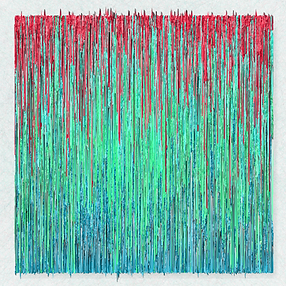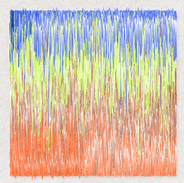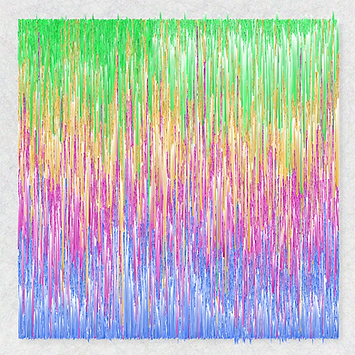
four &
random(four)
.png)
random(four) was inspired by four and substitutes tezos data with randomized inputs.
due to participation in the Blind Gallery event, both projects were released under my alt account.
an intro
Both of these projects began with @kaloh presenting the following prompt for the #blindgallery:
“Bear market, FUD, NFTs are dead, Right click save, economic recession, high inflation”
These themes immediately focused me on the importance of markets and price action, and how they drive the concepts of bear markets, recessions, inflation, FUD, etc. And because this was a blind release, I wanted to develop a project that was extremely aligned with the theme, different from my normal style, and inspired by my other interests. (I've always loved working with data and previously excelled in creatively crafting graphs/charts to effectively communicate a message.) As I reflected on the theme's prompts, I quickly honed in on the idea of using tezos price data as the key input. I knew there were unique ways to translate that data into something artistic. My biggest challenge, throughout the entire project, was a goal that I set from the beginning. I wanted to create a piece of art that--at first glance--would appear completely unrelated to price data, yet, after being prompted, it would be easy to see how price data drove the art. Finding this balance was more difficult than I expected.
In the early iterations of four, I tried to entirely avoid the use of randomized variables, but I eventually decided to allow for the randomization of hue and saturation as it dramatically improved the final output. As I randomized those variables, I began to explore further, maximizing the number of randomized inputs without entirely changing the project; this led to the creation of random(four).
I'd like to sincerely thank @kaloh for providing me the opportunity to participate in this event; it was a true honor. I have deep respect for the other artists and the beautiful work they created; if interested, you can view/purchase their #blindgallery submissions here.
four
Initially released on June 30, 2018, tezos has served as the blockchain of choice for many digital artists. four utilizes tezos price data to transform four years of emotions–fear, greed, excitement, and uncertainty–into generative art. Carefully engineered to balance art and its origins (as price data), the undulating waves and cavernous corners within four represent the rollercoaster of emotions and dark spaces we experience during market turbulence.
As it's not clearly evident, tezos price data was used as follows:
• Individual columns represent one day within a year, with 365 columns across the entire canvas.
• Respective years are represented by color, with hue being the primary driver.
- July 2018 - June 2019: tezos nascency, represented in white.
- July 2019 - June 2020: price stabilization, represented in blue.
- July 2020 - June 2021: momentum increases, represented in green.
- July 2021 - June 2022: enthusiasm followed by a deep decline, represented in red.
• Daily price is represented by the length of the colored section, compared against that same day in different years.
• Represented by the long triangle within each day of price data, daily volume is compared against that year’s annual low and high volumes.
• One additional use of volume data is the borders on each individual triangle. Thicker borders indicate higher volumes.
• Perhaps overlooked, there are only two uses of random() incorporated into the data, providing variation to the saturation and brightness.
_____________
The above message is the token's description, but I think the 'airdrop' hint was hidden a bit too well as I never saw this mentioned during the #blindgallery exchange window.
In the development of four, I explored various ways of translating the tezos price data into a generative art piece. Below are some samples that I ultimately decided against, and gives a glimpse into how my development process came together. The earlier iterations also utilize data from the crypto greed/fear index and google trends which I eventually eliminated for various reasons.

random(four)
random(four) takes the base code from four and substitutes randomized inputs for the tezos price data. In developing this project, I tried to keep random(four) closely linked to four while still allowing for sufficient variation.
One aspect that is not considered a trait is how the inputs (which replaced the tezos price data) are derived. All price data was replaced with a random number which then had one of various functions applied to it, including the incredibly useful functions from easings.net. The choice of function is what results in more/less blending of the years/colors, as seen in some of the examples below. In addition, the volume data was replaced by a random gaussian, building off of the previous day's data to encourage consistency while allowing for big shifts.

color combination
The only pre-determined color palette for random(four) is Black && White. All of the other palettes are selected based on a pre-determined means of combining hues, somewhat similar to what I used in rive. Each color combination begins with a randomly selected spot on the color wheel (using a scale of 0 to 360). In the below cases, they all begin with a hue choice of 351. From there, the code will choose colors based on a pre-determined distance from the original hue. For example, in the complementary example below, the additional hues were 171, 191, and 211 (which are 160, 180, and 200 away, respectively, from the starting point of 351).
All of the following color combinations result in four hues, except for split complementary and triadic. The saturation and brightness are randomized within pre-specified parameters to allow for sufficient diversity while minimizing the potential for completely washed out editions.
The Black && White color combination will oftentimes present the slightest hint of color when viewing zooming in.
.png)
18%
complementary
160, 180, 200

18%
triadic
120, 240

18%
split complementary
150, 210
.png)
18%
square
90, 180, 270

18%
tetradic
60, 180, 240

10%
black && white
_
background
There are two background options for random(four), dark and light. The background incorporates small amounts of color from the previously described color combinations, and also applies a small shadow to create the illusion of it being hung on a wall; both of these aspects are more evident with the lighter background.
stroke color
There are three stroke colors in random(four). To highlight the differences in stroke colors and how they influence the artwork, the following outputs use the exact same hash. The Black && White stroke marks can be applied to any output but are always applied when the Black && White color combination is selected.













.png)